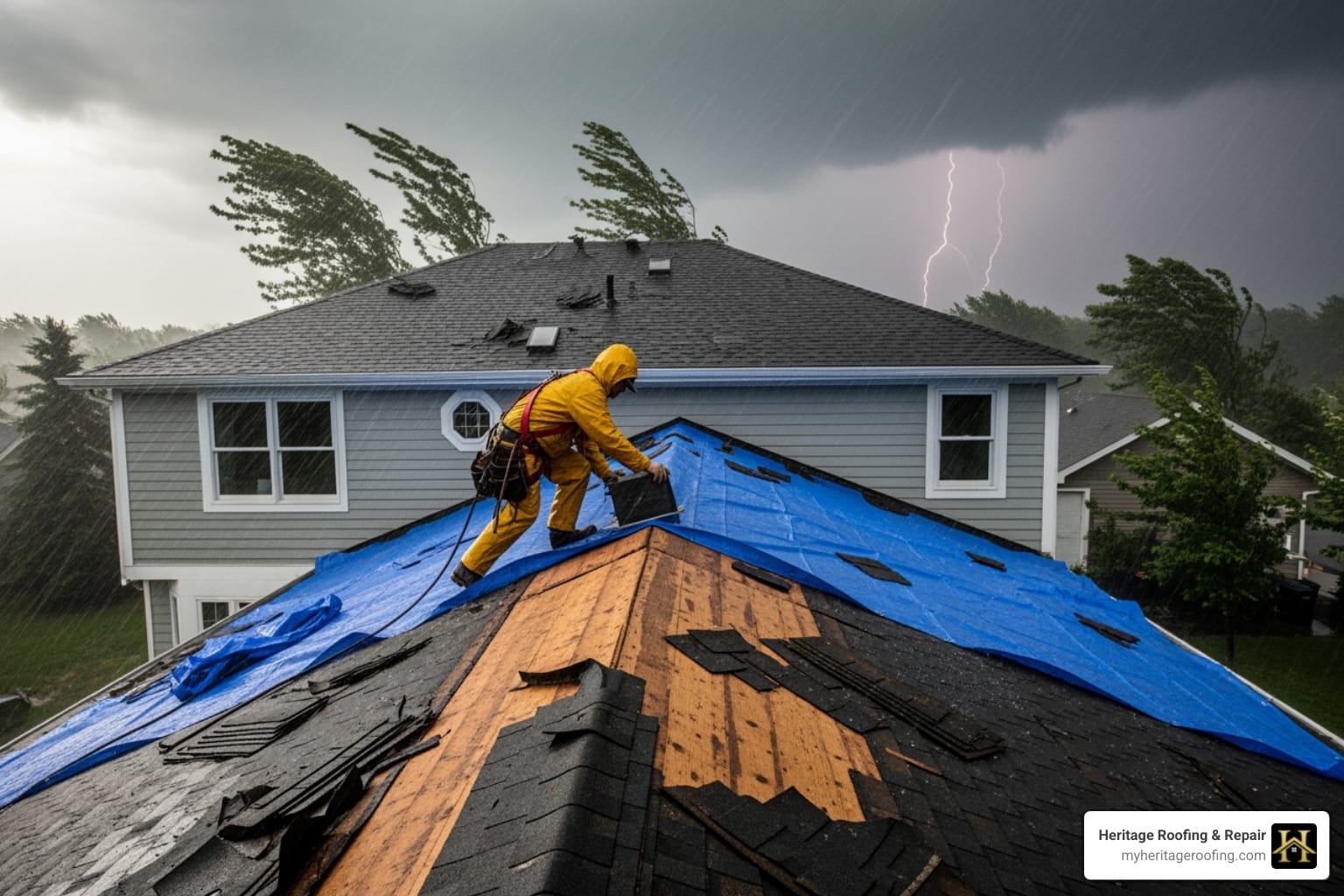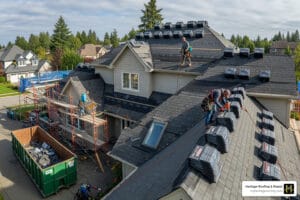When Seconds Count: Understanding Roof Emergencies
Emergency roof repair becomes necessary when your roof suffers sudden, severe damage that threatens your home’s interior and safety. Whether it’s a tree crashing through your roof during a storm or water pouring through your ceiling, knowing how to respond quickly can mean the difference between a manageable repair and thousands of dollars in structural damage. For immediate help, a trusted roofing company in Northwest Arkansas can assess and stabilize the situation fast.
Quick Action Checklist for Roof Emergencies:
- Ensure safety – Move family away from damaged areas
- Stop water entry – Place buckets under leaks, cover furniture
- Document damage – Take photos from ground level for insurance
- Apply temporary fixes – Use tarps to prevent further water intrusion
- Call professionals – Contact licensed roofing contractors immediately
The statistics are sobering: storms cause 60% of all roofing emergencies, and fixing problems early can save you 30-50% compared to delayed repairs. When disaster strikes, every minute matters in protecting your home from escalating damage.
As Rex Wisdom, owner of Heritage Roofing & Repair, I’ve responded to countless emergency roof repair situations across Northwest Arkansas over the past 50 years. Our family business has seen how quick action and professional expertise can turn a potential catastrophe into a manageable repair situation.

What Qualifies as a Roofing Emergency?
Not all roof problems are emergencies, but some demand immediate action to prevent catastrophic damage. An emergency is any situation where your home’s interior and structural integrity are immediately threatened. Ignoring them can lead to widespread water damage, toxic mold growth, and compromised structural safety. A true emergency roof repair is about stopping immediate threats to your home.

What constitutes a roofing emergency? It’s more than just a few missing shingles. We’re talking about:
- Severe Water Intrusion: Water actively pouring into your home, creating puddles, or rapidly staining ceilings and walls. This suggests a significant breach in your roof’s defense.
- Significant Structural Damage: Visible sagging sections of your roof, a large hole that exposes your attic or interior, or a roof that has been compromised by a fallen tree or major debris.
- Punctured Roof Deck: Any hole that goes through the roofing material and the underlying deck, allowing direct access for water and pests.
- Fire Damage: Even localized fire damage can compromise the structural integrity of your roof, making it an immediate hazard.
- Major Storm Damage: This includes widespread missing shingles, uplifted roofing materials due to high winds, or extensive hail damage that has compromised the protective layer of your roof.
- Ice Dams: While often a winter phenomenon, severe ice dams can force water under shingles and into walls, requiring urgent attention to prevent widespread water damage and mold.
- Pest Infestations: In rare cases, extensive pest damage (like large animal entry points) can compromise the roof’s integrity, leading to urgent repair needs.
Common Causes of Emergency Roof Damage
The forces of nature are often the primary culprits behind sudden roof emergencies. We’ve seen it all, and the most frequent causes include:
- Severe Weather Events: This is the big one. Storms are the biggest culprit for roof damage, causing billions of dollars in damage annually.
- High Winds Tearing Off Shingles: Strong gusts can lift and rip off shingles, exposing the underlayment and roof deck to the elements. Once a few shingles go, others can quickly follow, creating a domino effect.
- Hail Impact Creating Dents and Cracks: Hailstones, especially larger ones, can batter your roof, creating dents on metal roofs or cracking and dislodging granules from asphalt shingles, compromising their protective qualities.
- Heavy Snow Causing Structural Stress: While not as sudden, excessive snow accumulation can put immense stress on your roof’s structure, potentially leading to sagging or even collapse if not managed.
- Lightning Strikes: A direct lightning strike can cause severe localized damage, including punctures, charring, and structural compromise.
- Fire: Whether from an internal source or external, fire can quickly destroy roofing materials and the underlying structure, demanding immediate attention.
- Fallen Trees or Large Branches: As mentioned, this is a major cause. A tree crashing down on your roof is an undeniable emergency, often leading to a punctured roof deck and significant structural damage.
Understanding these common causes helps homeowners recognize the signs of a potential emergency and react swiftly.
The Dangers of Delaying Repairs
We can’t stress this enough: delaying an emergency roof repair is a costly mistake. It’s like ignoring a small cavity; it only gets bigger, more painful, and much more expensive to fix. The potential long-term consequences of delaying emergency roof repairs are severe:
- Mold and Mildew Growth: Water intrusion creates a perfect breeding ground for mold and mildew within your attic, walls, and insulation. This can lead to serious health issues for your family and extensive remediation costs.
- Rotted Framing and Sheathing: Constant exposure to moisture will cause the wooden components of your roof structure – the framing and sheathing – to rot. This compromises the structural integrity of your entire home.
- Damaged Insulation: Wet insulation loses its effectiveness, leading to higher energy bills as your HVAC system works harder. It also becomes a prime spot for mold.
- Compromised Electrical Systems: Water and electricity do not mix. Leaks near electrical wiring can cause shorts, power outages, and even fire hazards, putting your family at extreme risk.
- Ceiling and Wall Damage: Water stains, peeling paint, bubbling drywall, and eventually collapsing ceilings are all direct consequences of unaddressed roof leaks.
- Increased Final Repair Costs: A small leak ignored can lead to a full roof replacement or extensive interior renovations, costing thousands more than a timely emergency roof repair.
Emphasizing that waiting makes the problem exponentially worse and more expensive is not just a scare tactic; it’s a harsh reality we’ve witnessed countless times.
Your Immediate Action Plan: 4 Steps to Take When Your Roof is Damaged
When you find roof damage, your first moves are critical. Follow these steps to maintain control of the situation and protect your home from further harm while you wait for professional help. Your safety and the safety of your loved ones come first.
Step 1: Prioritize Safety Above All Else
We know it’s easy to panic when you see water pouring into your living room, but staying calm is paramount.
- Stay Calm: A clear head allows for rational decisions.
- Move Family and Pets to a Safe Area: Get everyone away from the immediate danger zone, especially if there’s a risk of structural collapse or electrical hazards.
- Turn Off Electricity Near Leaks: If the leak is anywhere near electrical wiring, outlets, or appliances, immediately turn off the power to that area at your circuit breaker. This is crucial to prevent electrocution or fire. Unplug electronics in the affected area until completely dry.
- Avoid Walking on a Damaged or Wet Roof: Unless you are a trained professional with proper safety gear, do NOT attempt to climb onto a damaged or wet roof. It is incredibly dangerous and can lead to serious injury or further damage.
- Be Aware of Downed Power Lines Outside: If the damage is storm-related, check for downed power lines around your property. Never approach or touch them.
Personal safety is more important than property. Do not take unnecessary risks.
Step 2: Assess and Document the Damage (From the Ground)
Once you’ve ensured everyone’s safety, it’s time to assess the situation without putting yourself in harm’s way. This documentation will be invaluable for your insurance claim.
- Walk Around the Property: From a safe distance on the ground, carefully walk around your home. Look for obvious signs of damage like missing shingles, large holes, debris on the roof, or parts of trees on your roof.
- Use Binoculars for a Closer Look: If you have them, binoculars are an excellent tool for inspecting your roof from the ground, allowing you to spot less obvious issues without climbing.
- Check the Attic for Leaks or Light Penetration: If it’s safe to enter, go into your attic. Look for water stains, drips, or actual streams of water. If you can see daylight through your roof, you have a significant puncture.
- Take Extensive Photos and Videos of All Damage, Inside and Out: This is critical. Document everything! Take clear photos and videos of the damaged areas, both on the roof (from the ground or a safe vantage point) and inside your home (ceilings, walls, floors, damaged belongings). This thorough documentation is essential for a smooth insurance claims process with your carrier. The more evidence you have, the easier it will be to justify your claim.
Step 3: Mitigate Damage with Temporary Fixes
After assessing and documenting, your next step is to prevent further damage. These are temporary measures, but they can save you a lot of money and headache down the line.
- Place Buckets Under Interior Leaks: This is the simplest and most immediate step. Position buckets, trash cans, or large containers under every drip or stream of water to collect it.
- Move or Cover Furniture and Valuables: Relocate any furniture, electronics, or personal belongings away from the leak area. If you can’t move them, cover them with plastic sheeting or tarps to protect them from water damage.
- Poke a Small Hole in Bulging Ceilings: If you notice a bulge in your ceiling, it often means water is pooling there. Carefully poke a small hole with a screwdriver or similar tool at the center of the bulge to allow the water to drain into a bucket. This prevents a larger, uncontrolled collapse of the ceiling.
- Use a Heavy-Duty Tarp to Cover the Damaged Exterior Area: This is your best friend for immediate external mitigation. A properly secured tarp can prevent thousands of dollars in water damage, mold, and mildew. Place the tarp over the damaged area, ensuring it extends at least 3 feet beyond the damage on all sides, and secure it firmly. If you’re unsure about climbing on the roof, leave this to professionals.
Here’s a list of essential supplies for a temporary roof patch that you might want to keep on hand for a quick fix:
- Heavy-duty waterproof tarp: Look for polyethylene or vinyl tarps, as they are durable and designed for outdoor use. Choose one slightly larger than the damaged area.
- 2×4 wood planks: These can be used to secure the tarp edges by wrapping the tarp around them and weighing them down or screwing them into the roof.
- Deck screws and galvanized washers: For securely fastening the wood planks and tarp without tearing the tarp material. Avoid drywall screws.
- Roofing cement or high-quality roofing tape: For sealing smaller cracks or securing temporary patches. Roofing tape is basically the epitome of quick fixes for your roof, sealing small cracks and gaps with ease.

Professional Emergency Roof Repair: What to Expect and How to Prepare
Once you’ve secured the immediate situation, it’s time to call in the experts. A professional roofer has the training, tools, and materials to safely and effectively handle your emergency. We understand that in a crisis, you need reliable help, fast.
How to find a trustworthy emergency roof repair contractor
In an emergency, it’s tempting to hire the first person who answers, but a few minutes of vetting can save you from scams and shoddy work. Here’s what we recommend:
- Look for 24/7 Availability: Reputable emergency roof repair companies understand that disasters don’t wait for business hours. We offer fast response times and are standing by day or night.
- Verify License and Insurance: Always ask for proof of licensing and comprehensive liability insurance. This protects you from any accidents or damage that might occur during the repair process.
- Read Recent Reviews: Check online reviews on platforms like Google Reviews (which are important for any business in Ontario, or in our case, Arkansas!), N49 Reviews, or Roofing.ca Reviews. This gives you insight into other customers’ experiences.
- Beware of “Storm Chasers”: After severe weather, unsolicited contractors, often from out of state, might appear offering quick fixes. These “storm chasers” are scam artists, plain and simple. They often do shoddy work, demand upfront payment, and disappear when problems arise. Always verify their local presence and reputation.
- Get a Written Estimate: Even in an emergency, a reputable contractor will provide a written estimate for the immediate work and any subsequent permanent repairs. This ensures transparency and avoids hidden costs.
The Professional Emergency Roof Repair Process
When you call us for an emergency roof repair, here’s what you can expect from Heritage Roofing & Repair:
- Initial Phone Consultation: We’ll ask you about the nature of the damage, its severity, and any immediate safety concerns. This helps us understand the situation and prepare our team.
- Rapid Dispatch and Arrival: We pride ourselves on our prompt response. Roofers typically arrive within 24-48 hours for emergency repairs, often sooner for critical situations. Our goal is to get to you as quickly as possible to prevent further damage.
- A Thorough Roof Inspection to Assess the Full Scope of Damage: Our experienced technicians will safely inspect your roof, identifying the source and extent of the damage. This might involve checking the attic, roof deck, and surrounding areas.
- Professional Tarping or Temporary Repairs: Our first priority is to stop the active leak and protect your home. We’ll expertly install a temporary tarp or perform other immediate fixes to mitigate further water intrusion.
- Detailed Estimate for Permanent Solutions: Once the immediate danger is contained, we’ll provide a comprehensive assessment and a transparent estimate for the permanent repairs needed. We’ll explain your options and answer all your questions.
- Scheduling the Final Repair Work: We’ll work with you to schedule the permanent repair at your convenience, ensuring your roof is fully restored to its pre-damage condition or better. We even offer a 5-year Workmanship Warranty on our repairs.
A reputable contractor follows a clear, professional process to restore your peace of mind, from the initial call to the final, lasting repair.
Navigating Costs and Contacting a Local Expert
The cost of emergency roof repair can vary widely. Factors influencing cost include:
- Damage Severity: A small patch is less expensive than extensive structural repairs.
- Materials Needed: The type and quantity of materials will impact the price.
- Time of Day/Week: After-hours or holiday services can add 20-30% to labor fees. This is why addressing issues during regular business hours, if possible, can save you money.
- Labor Complexity: Difficult-to-access areas or complex roof designs can increase labor costs.
Emergency roof repair costs can range from $300-$2,000+ depending on location and severity.
Working with your insurance company is also a crucial part of navigating the costs. We have extensive experience assisting with insurance claims for storm damage, helping you understand your coverage and facilitating the process.
For homeowners in Northwest Arkansas, having a local, trusted expert is invaluable. We are proud to serve communities like Berryville, Fayetteville, and Harrison, providing dependable, affordable, and quality craftsmanship. If you need immediate assistance with an emergency roof repair, don’t hesitate to contact us.
Local Contact Information:
Heritage Roofing & Repair
3458 Arkansas State Hwy 221, Berryville, AR 72616
Phone: Call (870) 654-1164
Prevention is the Best Medicine: Avoiding Future Roof Emergencies
The best way to handle an emergency is to prevent it from happening. Proactive maintenance is significantly less expensive and stressful than emergency roof repair. Think of it this way: an annual maintenance costing $200 can be compared to emergency repairs costing $3,000+. That’s a huge difference! Proactive maintenance can cut emergency repair costs by up to 60%. Roofs with routine inspections can save homeowners an average of $4,500 over 10 years.

Here’s how you can prepare for potential roof emergencies and keep your roof in top shape:
- Schedule Biannual Inspections: We recommend professional roof inspections twice a year, ideally in spring and fall. These inspections can catch minor issues like loose shingles, cracked flashing, or granule loss before they escalate into major problems.
- Keep Gutters Clean and Free of Debris: Clogged gutters prevent proper water drainage, causing water to back up under your shingles and potentially into your home. Regular gutter cleaning is a simple yet effective preventative measure.
- Trim Overhanging Tree Branches: Branches that hang over your roof pose a significant threat, especially during storms. They can scrape away shingles, or worse, fall and cause massive damage. Trimming them back reduces this risk.
- Address Minor Issues Promptly: Don’t procrastinate on small repairs. A single missing shingle or a small crack in your flashing can quickly lead to a major leak during the next rainstorm. Prompt attention to these minor issues can save you from a major emergency roof repair.
A small investment in routine roof repair and maintenance can prevent thousands of dollars in emergency costs. It’s like getting regular check-ups for your car; it keeps everything running smoothly and prevents breakdowns.
Here’s a quick comparison to highlight the benefits:
| Feature | Emergency Repair | Routine Maintenance |
|---|---|---|
| Cost | High (e.g., $3,000+) | Low (e.g., $200 annually) |
| Stress Level | Very High (panic, urgency, disruption) | Low (scheduled, planned, proactive) |
| Property Damage | High (water damage, mold, structural issues) | Minimal to None (prevents damage) |
| Timeline | Immediate, unplanned, disruptive | Scheduled, predictable, prevents disruption |
| Long-term Impact | Can lead to premature roof replacement | Extends roof lifespan by years |

Frequently Asked Questions about Emergency Roof Repair
We often get asked similar questions when homeowners are facing a roofing crisis. Here are some of the most common ones:
How much does an emergency roof repair cost?
The cost of an emergency roof repair can range significantly, typically from $300-$2,000+ for initial mitigation, depending on location and severity. The final price depends on the extent of the damage, the materials needed, and the complexity of the repair. After-hours or holiday services can add 20-30% to labor fees due to the urgency and specialized nature of the call-out.
How long can a temporary tarp stay on a roof?
A tarp is strictly a temporary solution, designed to prevent immediate water intrusion until permanent repairs can be made. While a high-quality, professionally installed tarp can last for several weeks or even a few months, it is not a permanent fix. Tarps are susceptible to wear and tear from weather, and they don’t provide the same level of protection or aesthetic appeal as a properly repaired roof. You should schedule a permanent repair as soon as possible to avoid further damage from moisture and exposure, as well as potential issues with mold or pests gaining entry.
Will my homeowner’s insurance cover emergency roof repairs?
Most standard homeowner’s insurance policies cover damage from sudden and accidental events. This typically includes damage from perils like storms, high winds, hail, and falling trees. However, they generally do not cover damage resulting from neglect, poor maintenance, or normal wear and tear. It’s crucial to document all damage thoroughly with photos and videos, and to contact your insurance agent promptly (usually within 24-48 hours after the incident) to understand your specific coverage and initiate the claims process. We can assist you in navigating your insurance claim to ensure you receive the coverage you’re entitled to.
Don’t Wait for Disaster to Escalate
A roofing emergency is one of the most stressful events a homeowner can face. But by staying calm, prioritizing safety, and taking swift, decisive action, you can protect your home and minimize the damage. Remember the key steps: ensure personal safety first, assess and document the damage from a safe vantage point, apply temporary mitigation measures to stop water intrusion, and then call a trusted professional for permanent solutions.
While proactive maintenance is your best long-term strategy for avoiding such crises, when disaster strikes, a fast response is everything. With over 50 years of trusted experience, Heritage Roofing & Repair is committed to providing dependable, affordable, and quality craftsmanship, specializing in storm damage repair and insurance claims for local homeowners and businesses.
If you’re facing a roof crisis in the Harrison area, don’t wait. Contact our team for fast, reliable emergency service. We’re here to help you weather any storm.




